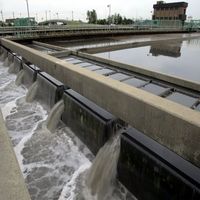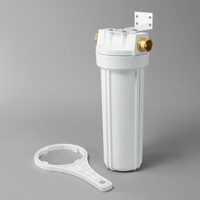The water from San Angelo, Texas’ Hickory Aquifer has seven times the allowable radiation level for drinking water. The radiation comes from an elevated level of radium. Radium is measured in picocuries per liter (pCi/L). The federal standard for radium in water is five pCi/L.
The standard is based on the notion that water above 5 picocuries raises the cancer risk at a rate of 2 cases for every 10,000 people who consume a half gallon of the water over a 70 year period.
The citizens of San Angelo are faced with a difficult decision on how to reduce the radium level in their water to an acceptable level. All options are expensive. Part of the expense is purchasing and operating the treatment equipment, but a considerable additional cost comes from getting rid of the waste from the treatment process.
There are two standard treatments for radium in water–reverse osmosis and cation exchange–plus a third strategy which does not remove radium but dilutes it with water from a non-contaminated source so that the blended water meets standards.
Reverse osmosis readily removes radium, but in doing so it adds it to a waste stream that must be disposed of. The reject stream, usually called brine, is about 10% of the total water volume. This ten percent waste stream is most easily disposed of by injecting it into a deep well specifically drilled for the purpose.
Cation exchange works exactly like home water softeners except that the softening resin is quickly contaminated and has to be trucked to a hazardous disposal dump at considerable expense. The water recovery rate is better than with reverse osmosis, but the spent resin disposal is costly.
Another possibility is a hybrid system that removes the radium from the brine from the reverse osmosis unit with ion exchange rather than pumping it into a well. With this method there is resin to truck away, but there is less of it. This method is the least expensive of the three over a 30 year period, but it requires the greatest initial capital outlay.
Finally, the dilution method produces no waste but requires very large amounts of uncontaminated water. In the case of San Angelo, this method is not being seriously considered because the water for blending is simply not available.
In the case of San Angelo, the projected 30-year cost of any of these treatments exceeds $100 million, as the table below indicates.
| Treatment Options | Waste Disposal Method | % Recovery | Cost |
| Ion (Cation) Exchange | Solid Waste (the spent resin) is trucked to Hazardous Waste Disposal | 99% | $116 million |
| Reverse Osmosis | Radium contaminated water to be injected into a deep well | 90% | $130 million |
| Reverse Osmosis with Ion Exchange Waste Treatment | Radium contaminated reverse osmosis waste is treated by ion exchange and the spent resin is trucked away | 99%+ | $102 millon |
| Dilution by blending with water from another source | Contaminated water is mixed with water from another source so that the resulting blend has <5 picocuries of radiation. | 100% | $116 million |
At this time (May of 2012), San Angelo is debating its course. San Angelo’s dilemma is mirrored in many of the nation’s communities.
Water changes with time, and more to the point, regulatory standards change. Radioactive water, after all, was marketed as a tonic just a century ago. Now it is a highly regulated contaminant that costs millions to remove from municipal water supplies.
As information grows about water contaminants, regulatory pressure felt by city water departments increases.
In recent years, the change in the federally mandated allowable level for arsenic has put many suppliers that were in compliance with the old standard in the difficult position of having to add expensive treatment equipment to protect the health of customers who are unwilling to have the cost passed to them in the form of higher water bills.
The use of chloramine in place of chlorine is an another often-unpopular change that has resulted from increased awareness of the health hazard posed by spin-off chemicals that result from chlorination.
The next great regulatory battle that the EPA faces is likely to be the need to set a maximum allowable level (MCL) for hexavalent chromium. When the MCL is established, whether suppliers may face $ millions in added expense depends entirely upon where the number is set. A few parts per billion one way or the other will amount to $ billions in treatment expense.
Protecting public health is the top priority, but water suppliers have their problems as well. My own view is that the solution to this dilemma of conflicting priorities must involve a compromise that takes into account the fact that only a small percentage of our processed water is actually used for human consumption. Surely it makes no sense to apply difficult and very costly treatments like those required for radium or arsenic reduction to water that is going to be used mainly for washing cars, watering golf courses, and flushing toilets.
The realities of our current water situation point to increasing use of point of use systems. Unless we plan to continue to truck tons of radioactive treatment resin to toxic waste sites, home treatment units to provide a small amount of top quality water for the home are in my opinion an essential part of a sensible overall water treatment plan.





![sci0804radiation485x512[1]](https://ymlp.com/https.php?id=purewatergazette.net/blog/wp-content/uploads/2012/05/sci0804radiation485x5121.gif)
